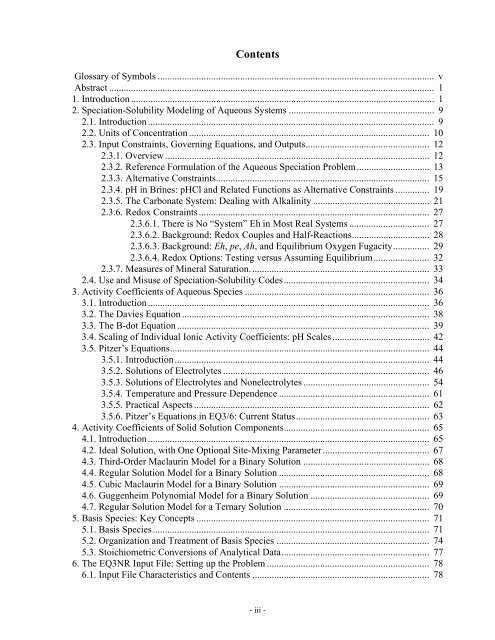EQ3NR, A Computer Program for Geochemical Aqueous Speciation ...
EQ3NR, A Computer Program for Geochemical Aqueous Speciation ...
EQ3NR, A Computer Program for Geochemical Aqueous Speciation ...
Create successful ePaper yourself
Turn your PDF publications into a flip-book with our unique Google optimized e-Paper software.
ContentsGlossary of Symbols .................................................................................................................. vAbstract ...................................................................................................................................... 11. Introduction ............................................................................................................................. 12. <strong>Speciation</strong>-Solubility Modeling of <strong>Aqueous</strong> Systems ............................................................ 92.1. Introduction ...................................................................................................................... 92.2. Units of Concentration ................................................................................................... 102.3. Input Constraints, Governing Equations, and Outputs................................................... 122.3.1. Overview ............................................................................................................. 122.3.2. Reference Formulation of the <strong>Aqueous</strong> <strong>Speciation</strong> Problem.............................. 132.3.3. Alternative Constraints........................................................................................ 152.3.4. pH in Brines: pHCl and Related Functions as Alternative Constraints .............. 192.3.5. The Carbonate System: Dealing with Alkalinity ................................................ 212.3.6. Redox Constraints ............................................................................................... 272.3.6.1. There is No “System” Eh in Most Real Systems ................................. 272.3.6.2. Background: Redox Couples and Half-Reactions................................ 282.3.6.3. Background: Eh, pe, Ah, and Equilibrium Oxygen Fugacity............... 292.3.6.4. Redox Options: Testing versus Assuming Equilibrium....................... 322.3.7. Measures of Mineral Saturation.......................................................................... 332.4. Use and Misuse of <strong>Speciation</strong>-Solubility Codes............................................................ 343. Activity Coefficients of <strong>Aqueous</strong> Species ............................................................................ 363.1. Introduction .................................................................................................................... 363.2. The Davies Equation ...................................................................................................... 383.3. The B-dot Equation ........................................................................................................ 393.4. Scaling of Individual Ionic Activity Coefficients: pH Scales........................................ 423.5. Pitzer’s Equations........................................................................................................... 443.5.1. Introduction......................................................................................................... 443.5.2. Solutions of Electrolytes ..................................................................................... 463.5.3. Solutions of Electrolytes and Nonelectrolytes .................................................... 543.5.4. Temperature and Pressure Dependence .............................................................. 613.5.5. Practical Aspects ................................................................................................. 623.5.6. Pitzer’s Equations in EQ3/6: Current Status....................................................... 634. Activity Coefficients of Solid Solution Components............................................................ 654.1. Introduction .................................................................................................................... 654.2. Ideal Solution, with One Optional Site-Mixing Parameter ............................................ 674.3. Third-Order Maclaurin Model <strong>for</strong> a Binary Solution .................................................... 684.4. Regular Solution Model <strong>for</strong> a Binary Solution .............................................................. 684.5. Cubic Maclaurin Model <strong>for</strong> a Binary Solution .............................................................. 694.6. Guggenheim Polynomial Model <strong>for</strong> a Binary Solution ................................................. 694.7. Regular Solution Model <strong>for</strong> a Ternary Solution ............................................................ 705. Basis Species: Key Concepts ................................................................................................ 715.1. Basis Species.................................................................................................................. 715.2. Organization and Treatment of Basis Species ............................................................... 745.3. Stoichiometric Conversions of Analytical Data............................................................. 776. The <strong>EQ3NR</strong> Input File: Setting up the Problem ................................................................... 786.1. Input File Characteristics and Contents ......................................................................... 78- iii -
















